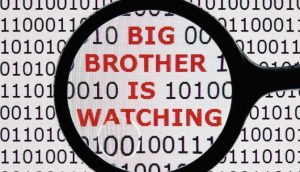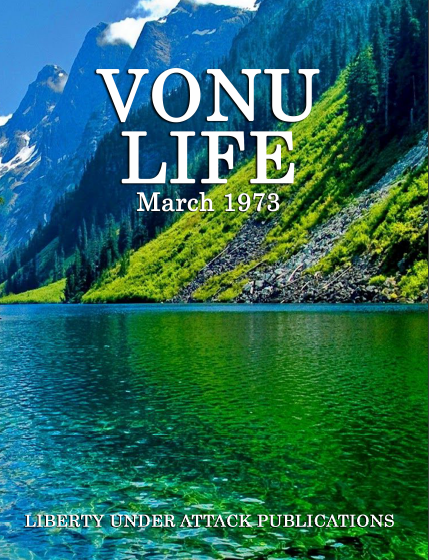Recently, I received a physical copy of VONULIFE, March 1973 and have been in the process of digitizing this 80,000+ word publication. As expected, it’s taking some time, but I figured I’d drop you another sneak peek. This is another BRAND NEW article (to “us”) by Rayo and I find it absolutely fascinating. Please enjoy, share, and keep a lookout for the full publication!
If you would like to help with the digitization process, we ARE looking for transcriptionists and proofreaders. Send me an email or contact us through the Facistbook page.

“There is no way to hide. They’ll soon have satellites in orbit which can count the hairs on a fly’s behind. So you might as well give up and become one of the sheep – like me.” Etc.
I have little inside information on Big Brother’s latest sky spies, but I discover that people who seem to delight in warning about them usually know less than I do. Here is what I’ve been able to learn.
The devices which PRESENTLY exist are costly and easily “faked out.” They are not in wide use.
Item: There are few things easier to detect with a heat sensor than a forest fire. It is much hotter than anything else in the woods. Yet, last I heard, the Forest “Service” is still depending on human observers, some in watch towers, some in aircraft, to spot smoke. They experiment with heat sensors and put out press releases now and then, but such devices are not in common use.
Item: Aerial photographs have been routinely used for map making since the 1940’s. And such photos are reportedly used by local property-tax accessors [assessors]. Quite likely large buildings and fields are being spotted. Small cabins in wooded areas are rarely spotted, even when no effort is made to hide them, according to property-owners I know.
Item: Squatters who have been discovered were first seen by persons (most often hunters) walking thru the woods. The one exception I’ve heard of had an open camp fire and was spotted from the air by the smoke.
Nevertheless surveillance devices will probably be improved and come down in price. Some may be widely used in 20 or 30 years. So it’s well to start learning what they can and can’t do.
One kind, which has been used in Vietnam, essentially consists of a microphone and a small radio transmitter. It is distributed on the ground, picks up sounds and radios them to processors which “listen” for human voices, internal combustion engines, clang of metal on metal, or other “unnatural” sounds. Although the individual devices are cheap, covering a large area with them is costly. And they are easily detected.
Another category of detectors, which may be carried by aircraft or satellites, make use of radiation below the frequency of visible light. Such frequencies do not respond to as fine detail as visual light does, which is one of the reason eyes sense the frequencies as they do. But these frequencies behave differently than visual light and the difference can be made use of. Examples: clouds are invisible at some radar frequencies. Metal shows up “white” regardless of its visual color, unless coated with a radar-absorbing substance. A hot, black stove shows “bright” to infrared. These frequencies can be thought of as additional colors.
For analogy, imagine a land where people see everything as shades of grey, as does black-and-white photography. In this land mottled orange-and-purple coveralls might be good camouflage – until someone invents color detectors. Then a vonuan must switch to a mottled green-and-brown. Similarly, an aluminum roof painted drab colors may be sufficient today. But if and when metal-sensing frequencies are in wide use, the aluminum must be covered with a substance that is also “drab” at those frequencies, or replaced with a non-metallic material.
Photographs can be taken with infrared and radar as well as visual light, and compared with photographs taken earlier to identify changes. Alteration of a small area is not easily spotted this way. Appearance will vary depending on time of day (shadows), day of the year, brightness of the sun, recent precipitation, and position of the aircraft. And changes caused by animals and weather must be distinguished by the work of humans. Of the latter, changes caused by “authorized personnel” (loggers, tourists, etc.) must be identified. Those remaining must be individually checked out by men on foot or let down on a rope from a helicopter. (There are few places in wooded, mountainous country a chopper can land.) This is time-consuming, potentially dangerous work. Aerial detection and data processing can be automated to a large degree to reduce costs. But investigation can’t. So Big Brother can’t afford a high percentage of “false alarms.”
In Vietnam there wasn’t much investigating. They simply bombed anything at all suspicious. The result? They tore up much of the land and killed many innocent bystanders at a cost of billions of dollars – without defeating their enemy. How likely are the bludg to destroy all the forests of North America as they have parts of Vietnam (which is a small country) just to “get” some people who only want to be left alone?
The Superstate may not survive in its present form for another 30 years. Even if it does the bludg are apt to be too occupied with day-to-day problems of staying in power to devote much of their resources to people who are not a direct and immediate threat. But assuming the worst, what might vonuans of the future do?
(1) Move now and then. If a spot is investigated in 1984 because it looks different than it did in ’82, this is no concern of someone who moved on in ’83.
(2) Create diversions. For example, it takes only a few minutes to arrange some branches to form a crude dwelling, drape light plastic over it (to provide solar heating for the benefit of heat detection), lay a little aluminum foil on the roof, and hang up a couple of tin cans so they bang together in the wind at irregular intervals. One person in one day can improvise enough decoys to occupy a crew of investigators for a year.
(3) Blend in. Millions of animals – bear, deer, porcupines, coyotes, packrats, elk, squirrels, birds, insects – are busy day and night altering the landscape in their quest for food – cutting, gnawing, prying, ripping digging, moving. Trees die, blow down, knock down other trees and bushes. A rock washes loose and rolls down hill, crushing vegetation and loosening dirt. If one disturbs the environment no differently than do other creatures, there is little to worry about.
More sensitive and discriminating detectors will be developed. But concealment and deception techniques will also improve. And technology favors the hider in a prolonged contest. A hider can always disguise, cover or randomize some more. Whereas the “noise level” of the natural environment is a limit beyond which the seeker’s detectors cannot economically go. Occasionally people will be found – concealment has its costs so one rationally employs just enough to reduce probability of discovery to a low level, not to zero.
In the immediate future I don’t believe “science fiction gadgets” will pose much of a threat. A human is a highly-sophisticated system of sensors and information processors, honed by hundreds of millions of years of evolution. An object or process which can’t be seen, heard or smelled by someone walking 100 yards away is not likely to be found. But artificial detection capabilities should be considered when developing new structures. My own guidelines:
Keep structures small, low and dispersed.
Use irregular shapes which blend with the terrain.
Build among trees and bushes when possible.
Do not use artificial heat. Build super-insulated dwellings which body heat will keep warm. Or build dwellings well insulated from the outside but not from the ground, for warming to ground temperature.
Build mostly of natural materials.
Minimize tree cutting. Cut only trees which are amongst other trees and away from the site.
Minimize use of metal. And use metal in small pieces. A plastic sheet covered with flakes of aluminum (electrically insulated from each other) is less detectable than a sheet of foil.
Use internal combustion engines little or not at all.
No open fires.
When digging, dispose of surplus dirt under dense bushes or in slide areas. Don’t dump in a creek or sprinkle over a wide area.
Keep flexible and fairly mobile. Don’t try to build a building or life-style to last a hundred years.



One Reply to “What is Big Brother Watching? by Rayo (VONULIFE, March 1973)”